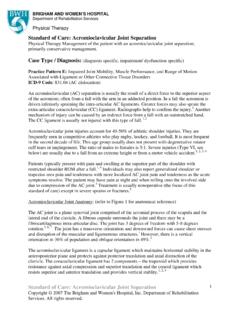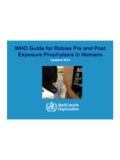Transcription of Muscle Edema -Recognizing Patterns and Associated Causes
1 Muscle Edema - Recognizing Patterns and Associated CausesHierl MS, MD, Yadavalli S, MD, PhD and Marcantonio D, MDBeaumont Health, Royal Oak, MIOakland University William Beaumont School of Medicine, MIDisclosuresThe authors do not have a financial relationship with acommercial organization that may have a direct or indirectinterest in the content. Educational review of Muscle Edema Patterns and distribution Emphasis on findings seen on magnetic resonance imaging (MRI) Correlate Muscle Edema Patterns with relevant clinical history Clinical data often helps in narrowing a differential or in making an accurate diagnosis Discuss relevance of other imaging modalities and usefulness of intravenous contrastGoals and ObjectivesIntroduction Muscle Edema is seen secondary to multiple etiologies including trauma, infectious and inflammatory processes, autoimmune disorders, neoplasms.
2 And denervation injuries On MRI Muscle Edema is characterized by increase in free water within the Muscle Muscle Edema is seen on MRI as increased signal on fluid sensitive sequencesT2 FSHigher signal to noise ratioSpecific fat suppressionSusceptible to inhomogeneous fat suppression STIRL ower signal-to-noise ratioHomogenous fat suppression T1 weighted images useful for evaluating Fatty atrophy of Muscle Subacute hemorrhage in presence of methemoglobin Contrast useful for evaluating for underlying infarction, tumor or abscessCauses of Muscle Edema Trauma Strain Contusion Laceration Denervation Rhabdomyolysis Delayed onset Muscle soreness Infection Pyomyositis Necrotizing fasciitis Viral myositis Inflammatory myopathies Dermatomyositis Polymyositis Connective tissue disorders Primary or metastatic tumor Radiation induced Medication related myopathy Vascular Myonecrosis Diabetic Muscle infarctionMuscle StrainB: Cor STIRC.
3 Cor T2 FS Muscle strain injuries at the myotendinous junction caused by forceful Muscle contraction Most common in muscles that cross two joints contain fast-twitch fibers and contract during elongation Muscle strain immediately painful More gradual development of pain with Delayed Onset Muscle Soreness A-B: Tear of the rectus femoris tendon centered along myotendinous junction C-D: Complete rupture of myotendinous junction of infraspinatus with extensive Associated Muscle Edema A: Ax T2 FSD: Sag T2 FSMuscle Contusion with Ischemia/Necrosis Muscle contusion results from direct injury, usually following blunt trauma Note feathery pattern of Muscle Edema and enhancement (ellipses) in patient with history of recent fall also note adjacent subcutaneous Edema (*) Areas of non enhancement (arrows) suggestive of underlying ischemia/necrosisB: Sag T1 FS/GdA.
4 Sag STIR*Denervation First few days imaging studies are often normal Late acute stage Earliest sign is increased signal in Muscle on T2 weighted images Subacute stage Progressive Muscle atrophy but Muscle Edema may still persist Chronic stage Muscle atrophy dominant finding fatty infiltration Affected muscles will follow the distribution supplied by the affected nerve Potential mechanisms of denervation Spinal cord injury, poliomyelitis, peripheral nerve injury or compression MR imaging may identify a correctable cause of nerve compression such as a prominent osteophyte or ganglion cystSuprascapular Nerve Entrapment suprascapular nerve compressed at: suprascapular notch affects supraspinatus and infraspinatus muscles Spinoglenoid notch affects only infraspinatus Muscle Patients present with non-specific posterior shoulder pain and weakness Causes include masses (paralabral or ganglion cysts), traction injury or traumaA-B: Note paralabral cyst (arrows) extending to spinoglenoid notch and resulting infraspinatus Muscle Edema (ellipse)B: Sag T2 FSA.
5 Ax T2 Anterior Interosseous Nerve Syndrome Anterior interosseous nerve Arises from the median nerve Pure motor nerve Supplies radial half of flexor digitorum profundus, flexor pollicis longus and pronator quadratus muscles Pronation weakness Pinching deformity due to weakness in thumb and index finger Edema and atrophy of the muscles Edema in pronator quadratus Muscle (ellipse) most reliable signAx T2 FSIschiofemoral Impingement Impingement of soft tissues between the ischial tuberosity and lesser trochanter May present with hip pain Middle age to elderly females Bilateral 25-40% Narrowed ischiofemoral space <15 mm and quadratus femoris space <10 mm Muscle Edema within the quadratus femoris Muscle (ellipses)A: Ax T2 FSB.
6 Cor T2 FS Clinical syndrome with gradual Muscle pain May take hours to days following strenuous exercise to develop symptoms Associated with exercise involving eccentric Muscle contraction Edema signal on MRI of the involved Muscle groups Elevated creatinine kinase (CK) levels Signal intensity correlates with serum CK levelsDelayed Onset Muscle SorenessA-C:Note extensive Muscle Edema (*) in patient who presented with severe pain and elevated CK levels 3 days after a 2 hour strenuous upper body work outA: Ax STIR**B: Ax T2 FS**C: Sag T2 FS**Pyomyositis Bacterial Muscle infection most commonly by Staph Aureus Many patients have underlying systemic illness causing immunosuppression Generally involves a single Muscle group May be multifocal Abscess - rim enhancing fluid collection (circle) within areas of Muscle Edema and enhancementA: Ax STIRB: Ax T1 FS/GdParsonage Turner Syndrome Acute idiopathic brachial neuritis Sudden onset of shoulder pain and/or weakness of shoulder girdle musculature Exact etiology uncertain viral or autoimmune process suspected Supraspinatus and infraspinatus muscles frequently involved followed by the deltoid Muscle Prolonged course can lead to Muscle atrophy A-B.
7 Note Muscle Edema (*) in the supraspinatus and infraspinatus muscles and to a lesser extent in the lateral aspect of deltoid muscleA: Cor PD FS**B: Sag PD FS**Polymyositis and DermatomyositisA: AxT2 FSB: Cor STIR Autoimmune inflammatory conditions Gradual onset of Muscle weakness affecting proximal pelvic girdle Later involves proximal muscles of upper limbs Degree of Muscle Edema correlates with disease activity can direct Muscle biopsy Polymyositis only involves skeletal Muscle Dermatomyositis also involves the skin Adult onset dermatomyositis Associated with increased prevalence of malignancy Sheet-like calcifications may develop in dermatomyositis A-B: Note diffuse Muscle and subcutaneous Edema in upper extremity of patient with dermatomyositisSarcoidosis Uncommon Myopathic or nodular types Myopathic type Symmetric proximal Muscle atrophy Increased signal intensity of involved Muscle on T2 weighted images Nodular type Focal intramuscular masses, usually at myotendinous junction Have appearance described as dark star with central areas of low signal indicating fibrosis May be difficult to see on radiographsC: Humerus RadiographA: Ax T1B.
8 Ax T2 FSCalcium Hydroxyapatite Deposition Disease Radiographs Lobular soft tissue calcifications (arrows) MRI Low signal on all sequences (arrows) In acute phase can result in significant Muscle Edema May be mistaken for a neoplasm Correlation with radiographs or CT important to avoid misdiagnosisC: Sag PD FSB: Ax PD FSA Systemic disease of unknown etiology Periarticular or intra-articular deposition of calcium hydroxyapatite crystals Along tendons, capsule, ligaments or bursae Can erode into the bone Localized pain, swelling and tenderness Can resolve over a few months Shoulder is the most commonly affected region Especially the supraspinatus tendonPrimary Soft Tissue Neoplasm Usually appears as a focal enhancing mass May be Associated with Peri-tumoral Edema Internal hemorrhage/necrosis Muscle Edema may be seen with benign and malignant tumorsA: Ax T2 FSB.
9 Ax T1 FS/GdPost Radiation Therapy Causes vasculitis and tissue injury Edema throughout the radiation field Uniform Muscle Edema Geometric margins Extends uninterrupted across Muscle and subcutaneous fat Edema signal Can increase over 12-18 months Can persist for many yearsA: InitialAx T2 FSB: 1 yr F/U Ax T2 FS Post Radiation Sarcoma Radiation induced sarcoma can originate in irradiated bone or soft tissue Risk Occurs after latency of around 14 years Can occur 3-4 years following radiation therapy Poor prognosis in comparison to primary sarcoma A-D: Sarcoma in patient with history of radiation treatment for prostate cancerD: Ax T1 FS/GdA: CT Ax/+CB: Ax T2 NFSC: Ax DiffusionDiabetes Related Muscle Infarct Long standing, poorly controlled diabetes Abrupt severe thigh or calf pain Possible low grade fever Pathogenesis uncertain microangiopathy has been suggested Muscle enlargement with Muscle Edema (*) fascial Edema Diffuse heterogeneous Muscle Edema MRI Increased signal on fluid sensitive sequences Nonenhancing regions represent myonecrosis Ultrasound (US) Heterogeneous hypoechoic muscleB: US*A.
10 Ax T2 FS*Ruptured Popliteal Cyst Fluid in the synovial lined gastrocnemius-semimembranosus bursa Complications of popliteal cyst Dissection Rupture Compression Hematoma Compartment syndrome Acute calf pain Swelling Neoplasm with hemorrhage may have similar appearance Follow up imaging may help to confirm resolution/improvementB: Cor STIR*A: Ax T2 FS**A-B: Ruptured popliteal cyst with hemorrhage dissecting between soleus and gastrocnemius muscles (ellipse). Associated Muscle Edema (*). There are many Causes of Muscle Edema signal on MRI exams These include trauma, infectious and inflammatory processes, autoimmune disorders, neoplasms, denervation injuries and iatrogenic etiologies Important for radiologists to recognize distribution and Patterns of Muscle Edema and to correlate with clinical history in order to make a correct diagnosis In some cases correlation with CT and radiographs may also help in making an accurate diagnosis Delayed or misdiagnosis may result in delayed treatment or unnecessary interventionSummary May et al.





